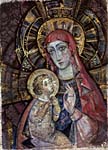Forgive me for yesterday’s wacky post. I’m rounding the final turn of a new wood block—the first I’ve executed outside the workshop environment. The spot I’ve set up in the little galley kitchen on the second floor is ideal. Painters need soft northern light, but the way the afternoon sun from the small window streams by my left shoulder is perfect for engraving wood. I can see each minute detail with total, three-dimensional clarity. Gray loaned me a magnifying visor, but I prefer the naked eye, as long as I have the proper light.
Why does wood engraving appeal to me? There’s something about the precision that satisfies an inner aspect, much in the same way that the spontaneity of collage appeals to another part of me. Perhaps Wesley put it best when he wrote, “Engraving is like drawing on a black board. Every line you make is a white mark on a black surface. You are adding light to darkness.” That hits pretty close to home for me.
On the other hand, it’s widely acknowledged that wood engraving is a demanding, unforgiving medium. I’m considered fairly decent for a “beginner,” but that’s because I can tap a lifetime of graphic investigation as I make each binary decision—black or white? I still have a significant mark-making technique to learn and “muscle memory” to acquire. I must also develop an even deeper resistance to haste. There are no shortcuts, “happy accidents,” or undo keys in wood engraving. Every mark must be deliberate. The process does not reward chance; it yields only to planning and tenacity. I find a challenge in all that, obviously, but I wish I’d been more strongly captivated by it earlier in my artistic life. After creating the lino block for Joan and Wayne’s wedding invitation, I abandoned printmaking for nearly 30 years. So be it. I’m slowly making up for a bit of lost time.
 Recently she chose Dana as the person to provide her personal assistance while recuperating from a broken hip. When we visited to pick out one of her works, she offered to loan me an art book from her collection. The first one I saw had КРАВЧЕНКО on the spine, a name that meant nothing to me. I thought it might be pronounced “Kravchenko,” but Irina seemed to be saying, “Kravkinkja,” so I looked inside. I was stunned by the reproductions. Who was the artist Кравченко? Without a doubt, one of the greatest Russian wood engravers of the early 20th Century.
Recently she chose Dana as the person to provide her personal assistance while recuperating from a broken hip. When we visited to pick out one of her works, she offered to loan me an art book from her collection. The first one I saw had КРАВЧЕНКО on the spine, a name that meant nothing to me. I thought it might be pronounced “Kravchenko,” but Irina seemed to be saying, “Kravkinkja,” so I looked inside. I was stunned by the reproductions. Who was the artist Кравченко? Without a doubt, one of the greatest Russian wood engravers of the early 20th Century.
